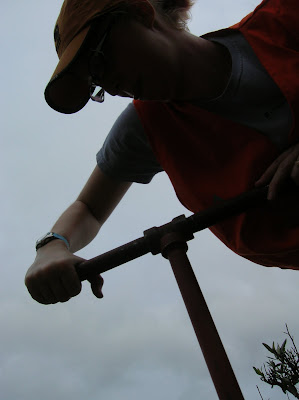


Today was the first day we were at La Corona for lunch. On our other days here, Sonia packs us a lunch complete with silverware, napkins, bottled water, and plenty of food. I think we've brought back food each day because there was too much to eat in one sitting. In the field, she's packed us sandwiches with breaded, fried meat (sandwich milanese) in them and also some fruit, she's assembled a rice dish that included tuna and corn (which was oddly tasty), and yesterday she packed us breaded, fried spinach patties and ham sandwiches.

Tonight, he cooked another good meal. This was more modest than some of the other's that Sonia has prepared, but no one is complaining here. We had thin cutlets of chicken, seasoned with herbs and pan fried. They were served with mashed potatoes. I missed the veggies a little at this meal, but I figure between the salad at lunch and the veggie-centric meal we had last night with the quiches and salad, I'm probably still doing okay.

Every dinner seems to be served with baskets of bread. Because of the humidity, it's common practice to serve things that don't dry out as fast as a loaf of bread. Instead, these are made as a cross between bread and a cracker. To the right, these little squares bake up into small towers of layers of dough. You can peel them apart and eat them separately. The crackers on the left are more what we're used to.

Dessert again. At first we thought that every dinner comes with a dessert, but after lunch we realized that every meal (except breakfast) is follwed with something sweet. Tonight it was arroz con leche, which was awesome. It's a traditional dessert in Uruguay, especially in the countryside. He gave us a taste of it before dinner to make sure we liked it. When it came time for dessert he asked us if we preferred the arroz con leche or ice cream. I'm not one to pass down the local delicacy...
This dessert is like a very thin rice pudding. It's mostly cooked milk with a little bit of rice in it, and sweetened. He suggested we top our bowls with a few shakes of ground cinnamon, which really made it taste great.

Stuffed, and tired from the sun and humidity, I'm off. Buen noche...




























 We also saw a group of donkeys ("burros") after a wrong turn during our field visits with Juliana. With most of the fencing, especially near La Corona, there is a gate to move cattle through, and also a path for cars that has parallel posts lying on the ground to make a grate. We'd call these a type of cattle grates, but here they are called mata burros (in other words, donkey killers).
We also saw a group of donkeys ("burros") after a wrong turn during our field visits with Juliana. With most of the fencing, especially near La Corona, there is a gate to move cattle through, and also a path for cars that has parallel posts lying on the ground to make a grate. We'd call these a type of cattle grates, but here they are called mata burros (in other words, donkey killers). They don't mince words here...
They don't mince words here...











